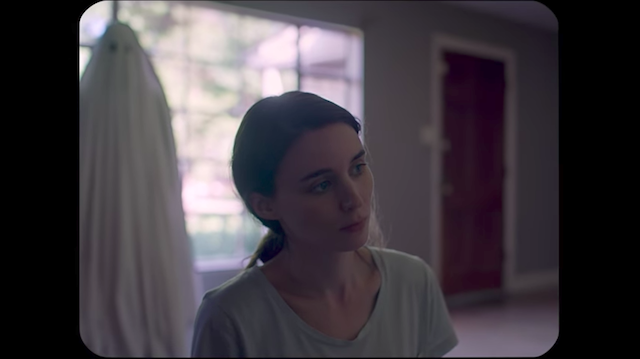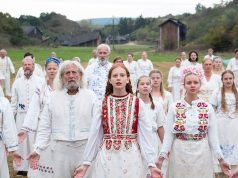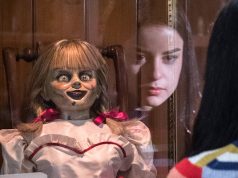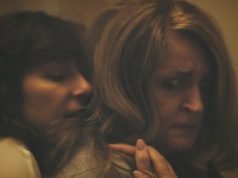
“A Ghost Story” is indeed a story about a ghost, but that’s where the similarities between it and, say, “Poltergeist” stop. Written and directed by the contemplative David Lowery (“Ain’t Them Bodies Saints,” “Pete’s Dragon”), this is more of a melancholy love story and a rumination on the passage of time. Framed like an old photograph, nearly square with rounded corners, the film has a great beauty to it, notwithstanding some patience-trying stretches.
We never learn the names of our protagonists, played by Casey Affleck and Rooney Mara; the credits call them C and M, respectively. They’re a married couple who live mostly happily in an old suburban house until C dies and returns as a ghost. Not the scary kind, either, but the trick-or-treat kind: a white sheet with eye holes cut out. Silent and unseen, he observes M as she grieves, recovers, moves on.
Time passes for C as in a dream. He sees M with another man and immediately lashes out in anger, knocking books off a shelf (as ghosts do) — only it’s not “immediately,” it’s the next day, or several days later. He can’t keep up with chronology. He tries, in his ghostly fashion, to pry a scrap of paper from the wall where M hid it; when he glances up, years have sped by and the house has new occupants. Standing at the window, C communicates (silently) with a fellow ghost in the house next door who’s also waiting for someone, also in vain.
Structurally, the movie is built on a combination of montages and long, unbroken takes, on silence as well as Daniel Hart’s plaintive musical score (which is often stretching, yearning, never resolving). Perhaps because time isn’t measured on the spiritual plane, Lowery freely hops around the timeline (timecircle?), showing us the mundane togetherness and minor disagreements of C and M’s marriage before leaping even further back and further ahead.
By far the talkiest, least abstract part of the film is a scene where the house that once belonged to C and M is the site of a party, during which a man (Will Oldham) monologues about life, the universe, and everything as C listens. Here’s where Lowery’s themes are summarized: we try to leave a lasting impression on the world even though nothing lasts; all we have is now.
Though this isn’t a horror film, a word applies that is often used to describe them: haunting. Only it’s not ghosts or demons that haunt us, it’s mortality and the unstoppable march of time. The helpless sense that time is passing too quickly, felt by all adults at some point in their lives, is no less poignant for being exaggerated in C’s case. What’s curious is that Lowery is able to convey deep feelings vividly despite the character with the most screen time not having a face for most of it. The hollow, oval-shaped eye holes in C’s sheet look perpetually sad, enhanced by the somber absence of a mouth. He can see but he can’t communicate. We know how he feels.
To help us appreciate the weight of passing time in a film that is only 92 minutes long, Lowery uses cinematic tricks like “dragging things out” and “making us watch what feels like nothing for what actually is several minutes.” The most notable of these is an early sequence in which M grief-eats most of an entire pie brought to her by a friend after C’s death. In two long takes totaling more than four minutes, M silently cries and chews while her ghost husband stands motionless nearby. Mara’s performance is effective (and harder to pull off than it looks), but in this and a few similar instances you think: Could this maybe be a minute shorter without losing its impact?
Nonetheless, Lowery takes huge risks here, casting known actors in an experimental tone-poem of a movie that could easily have been an insufferable disaster. If some sections of it are more wearying than enlightening, that’s outweighed by the unforgettable emotional experience of seeing eternity pass before your eyes.
B+ (1 hr., 32 min.; )





